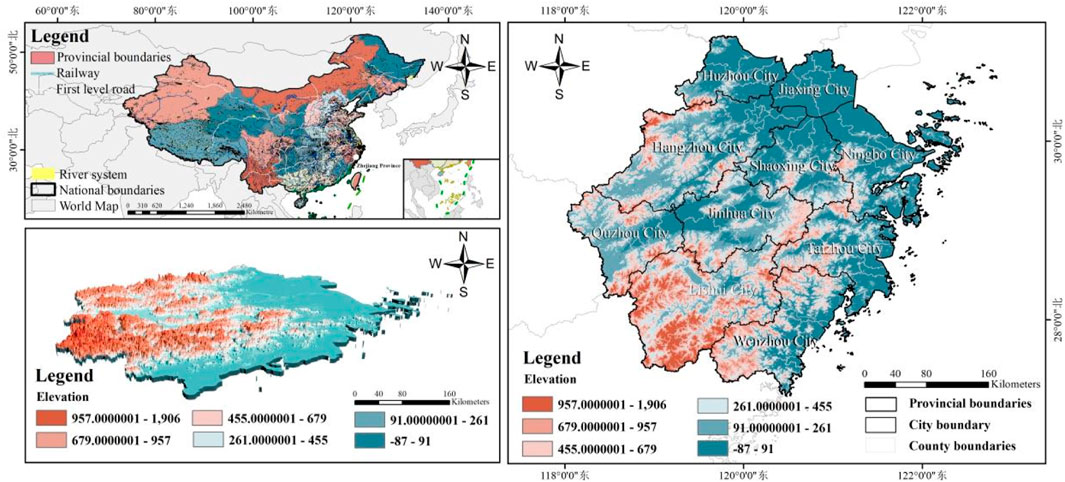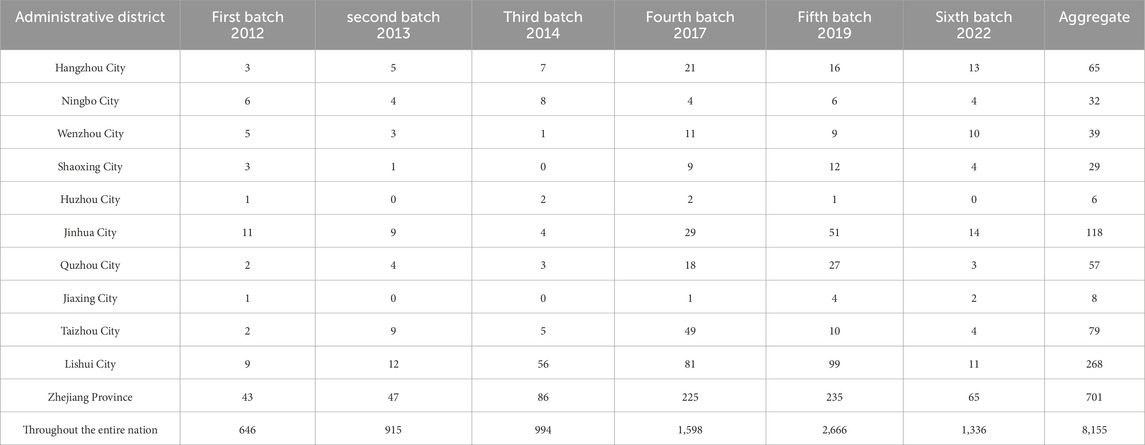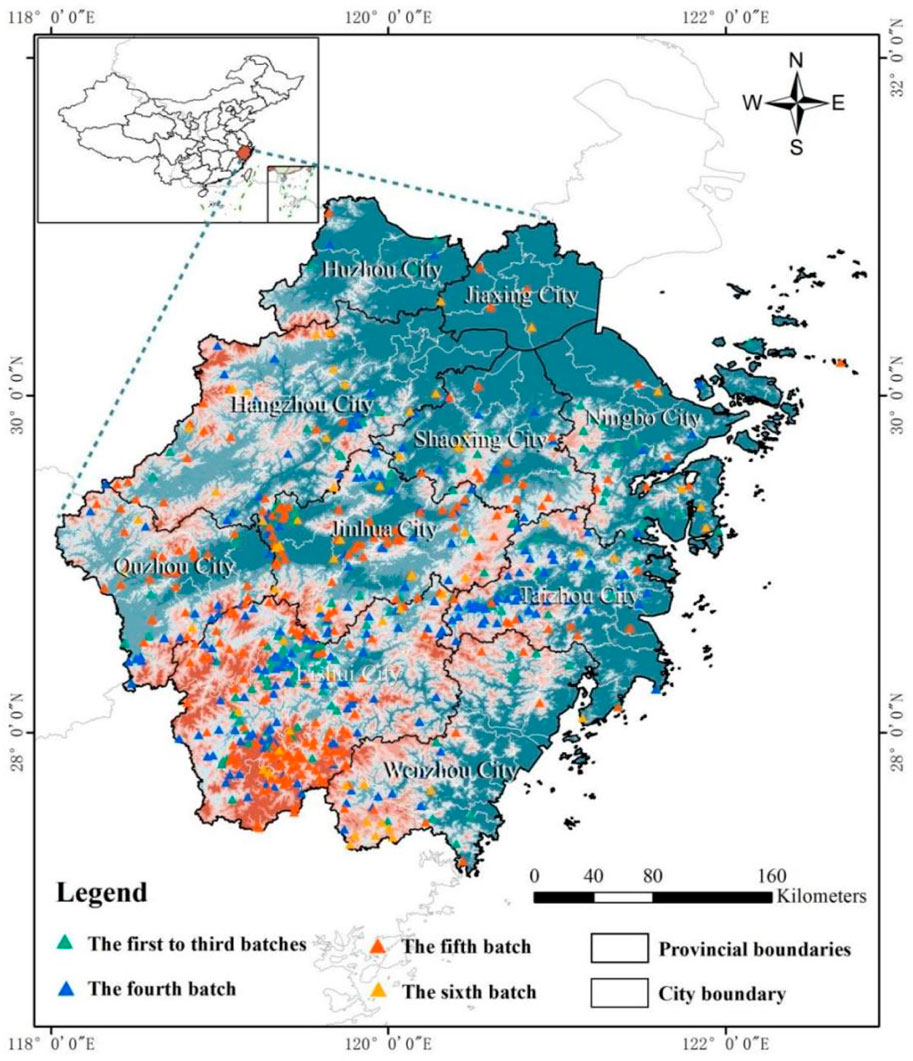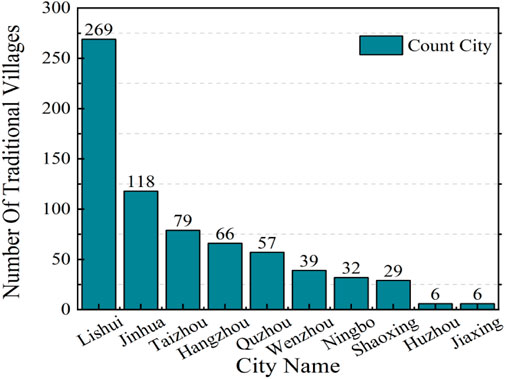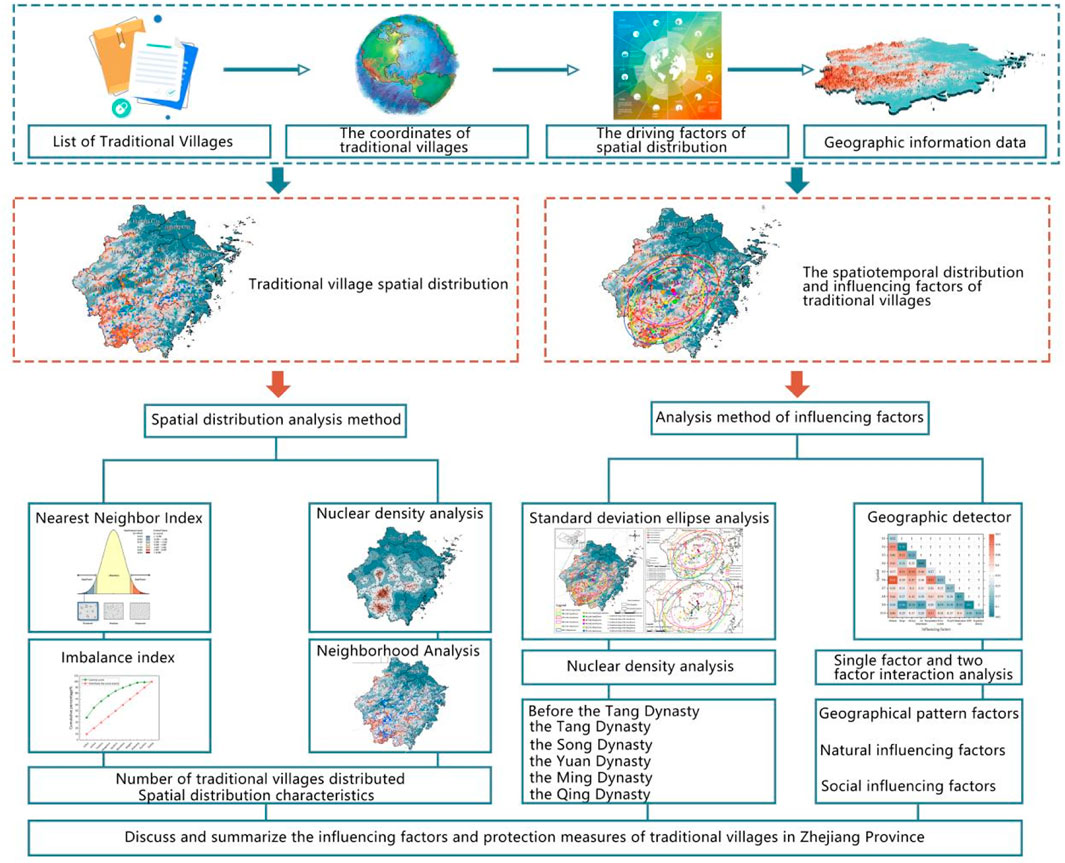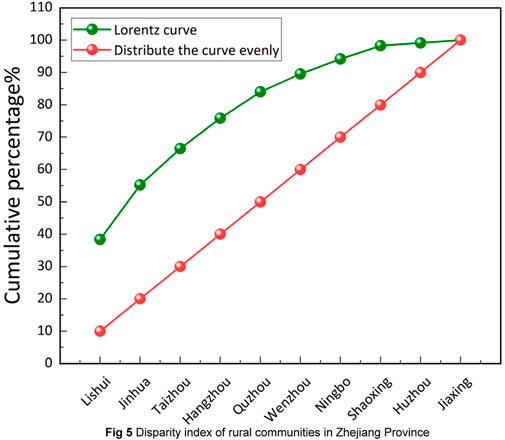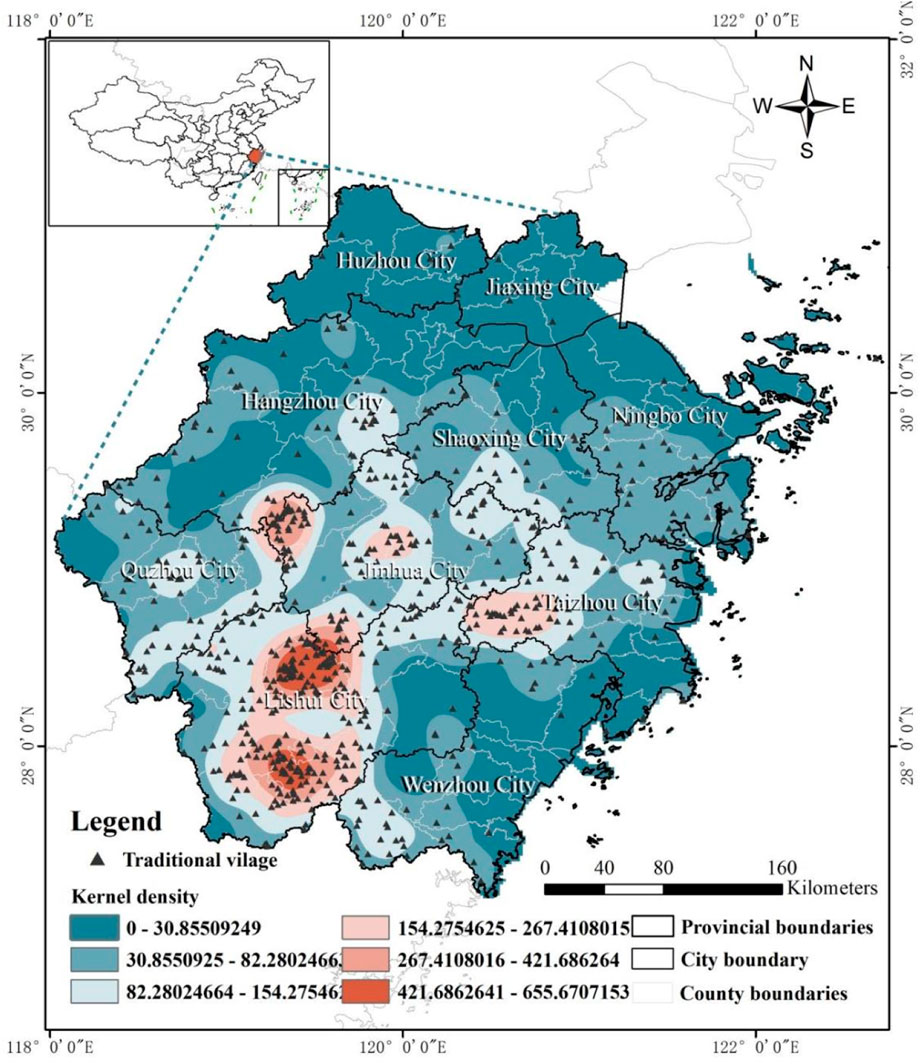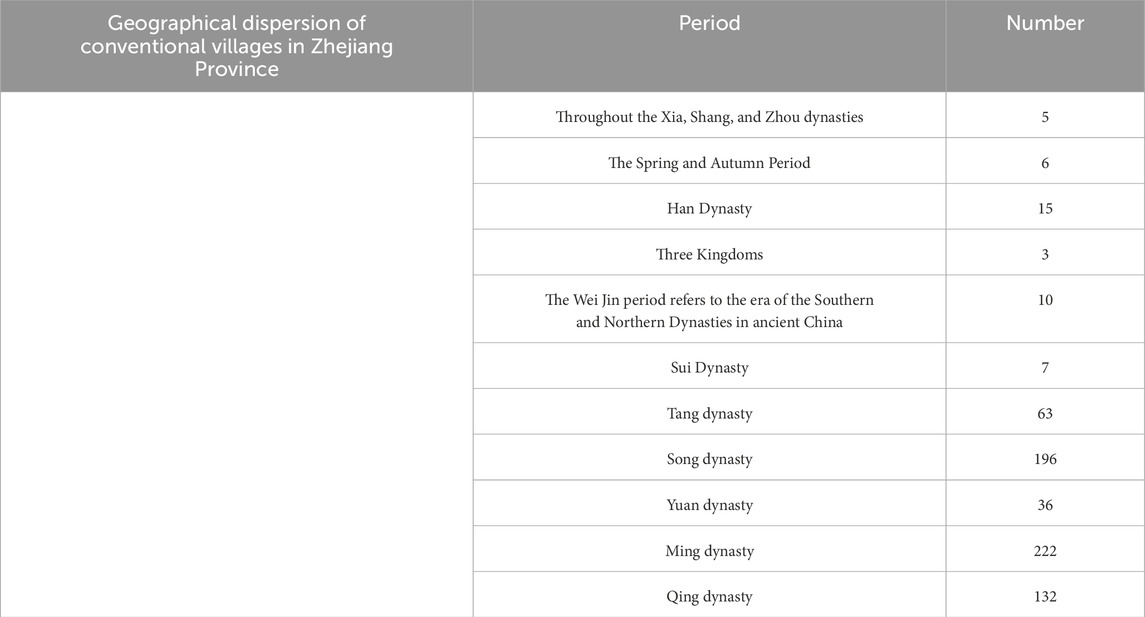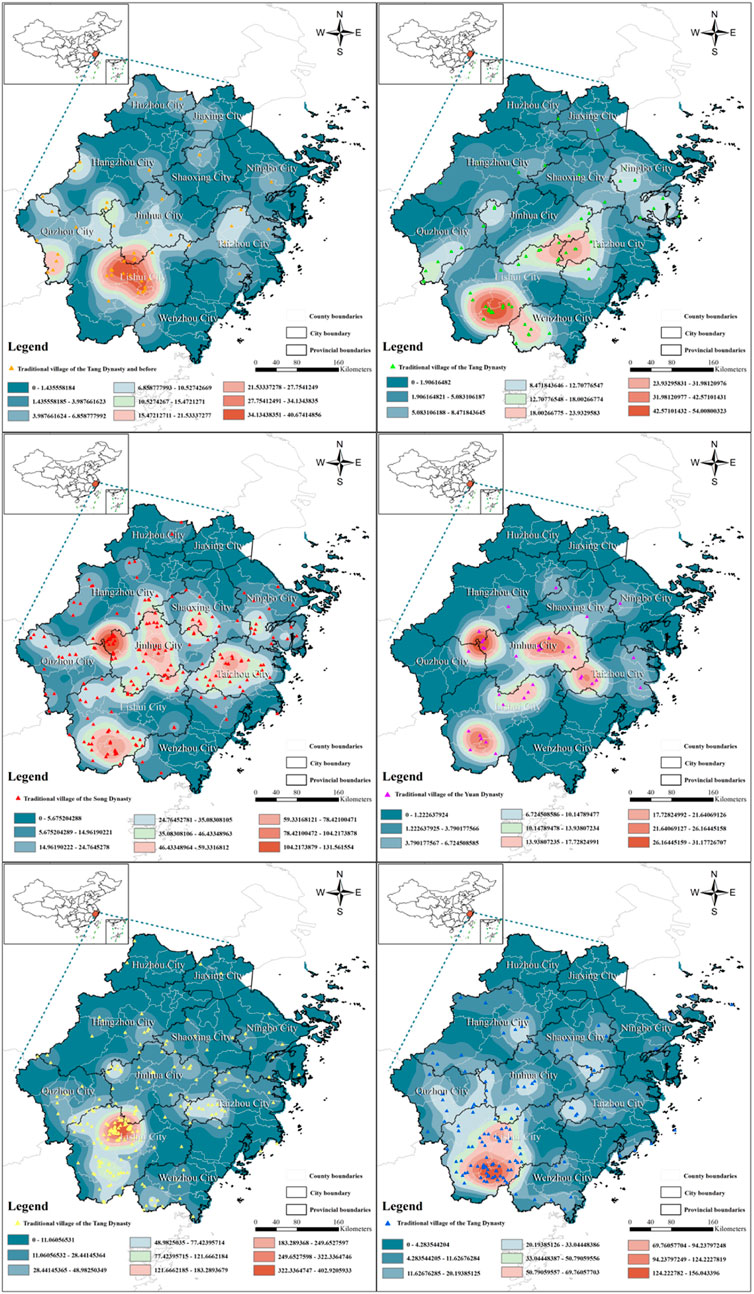- 1National Cultural creative Industry Research Center, Xinjiang Hetian College, Hetian, China
- 2Community Development Research Center, Anhui University, Hefei, China
- 3School of Art and Design, Yanshan University, Qinhuangdao, China
- 4Psychology Department, Durham University, Durham, United Kingdom
Introduction: Traditional villages in China, with a history spanning over thousands of years, reflect significant socio-cultural evolutions and ecological adaptations.
Methods: In order to deeply explore the multidimensional factors affecting the layout and survival of villages, this study uses geographic data analysis, historical documentation, and ArcGIS 10.8 tools and applies spatial analysis methods such as kernel density, nearest neighbor index, disequilibrium index, and geodetic detector to characterise the layout of traditional villages and their influencing mechanisms in Zhejiang Province from the perspectives of spatial distribution, historical evolution, natural geography, and socio-economics. A systematic study was carried out.
Results: The results of the study show that (1) the distribution of traditional villages in Zhejiang Province presents an unbalanced pattern of ‘double core and peripheral dispersion’, mainly concentrated in Lishui and Jinhua, with water resources and topographic conditions as the basis for aggregation; (2) the distribution of villages advances from northeast to southwest, reaching the peak of development in the Song, Ming, and Qing dynasties, reflecting the changes in national political policies This reflects the far-reaching influence of national political policy changes and ecological changes on village development; (3) Historical, geographic and social factors jointly play a role in the distribution of villages, in which geographic and natural factors such as elevation, precipitation, slope direction and water system dominate the siting and layout of villages.
Discussion: This study identifies the key influence mechanisms of factors such as elevation and water system on the distribution of villages, enriches the understanding of the spatial pattern and development mode of traditional Chinese settlements, and provides references for the sustainable development and cultural preservation of traditional settlements around the world.
1 Introduction
Traditional villages serve as a valuable repository of traditional Chinese culture, preserving the essence of this cultural heritage and embodying deep historical significance and cultural landscapes. Specifically, ancient towns that have existed for centuries or even millennia are physical embodiments of China’s exceptional traditional culture, typically showcasing unique local attributes. Artifacts can mirror human social life, industrial techniques, cultural customs, architectural designs, and natural surroundings in a specific era, possessing significant historical and artistic worth. Nevertheless, due to the rapid growth of cities and the establishment of new rural urbanization, traditional villages are facing a constant reduction in their living space (Fu et al., 2021). Furthermore, many villagers need a conscious understanding of the need for preservation, leading to limitations in resources and the migration of the labor force (Chen et al., 2024).
Consequently, traditional villages are gradually disappearing in the course of global evolution. According to China’s Guangming Times, the number of traditional villages is declining at an average rate of 7.3% per year, resulting in the disappearance of 1.6 traditional villages daily. At the same time, the mechanism of influence of natural, economic, cultural, and other multidimensional factors on the layout and survival of villages has yet to be fully explored academically. Systematically analyzing the spatial layout characteristics of traditional villages, the main influencing factors, and their historical evolution patterns have important theoretical significance and provide a scientific basis for village protection and planning. Only by clarifying the core factors affecting the layout of traditional villages and profoundly understanding the driving mechanism behind their evolution can we formulate locally adapted protection strategies and realize the organic combination of cultural heritage and sustainable development of villages. Therefore, it is important to analyze traditional villages’ spatial pattern characteristics systematically. How can the multiple influencing factors behind traditional villages and their functioning mechanisms be analyzed? How to provide theoretical support and practical guidance for protecting and developing traditional villages. It has become an important proposition for protecting and developing traditional villages.
International research on the cultural landscape of traditional villages started early (roughly in the 1960s). Under the impact of postmodernism, post-productivism, rural multifunctionality, and other factors, there has been a growing focus on and emphasis on the cultural landscape space, historical and cultural structure, and social power representations of traditional villages (Li XQ. et al., 2023). While China’s research on traditional village cultural landscapes started late, scholars began to explore traditional village cultural landscapes one after another in the 1990s, in which protection and development were the most concentrated areas of research. However, ineffective protection of missing genes still exists due to cultural disconnection and lack of characteristics, and there is an urgent need to innovate the protection mode and update the development path (Meng et al., 2024).
Internationally. Tobias Plieninger emphasized the importance of rural landscapes as humanistic landscapes and believed that human feelings and experiences should be valued in the conservation process (Plieninger et al., 2006). Luisa et al. scholars believe that cultural heritage can be preserved through ICT tools to protect territories and historical architectural identities and restore and enhance cultural heritage (Luisa et al., 2023). Valjarević et al. explored the key role of urban-rural interactions of Serbian settlements in the formation of urban agglomerations through GIS spatial analysis methods, and their study provides useful international references for understanding the mechanisms of urban-rural settlement interactions (Valjarević et al., 2020). Currently, all international narratives from the perspective of humanistic landscapes and advanced science and technology mainly present advanced scientific and technological protection and humanistic use experience. In the Chinese study, more analysis of the evolutionary factors of traditional villages needs to be conducted from a macro and spatio-temporal perspective. Scholars of Chen et al. used the cultural ecosystem framework to analyze the spatial evolution of villages, combining natural, economic, and social environmental factors and exploring villages’ formation and evolution process in-depth, providing insights into protecting traditional villages (Chen et al., 2020). However, the study only focuses on a single village case, and the results are difficult to generalize to villages in different regions. Scholars of Gao et al. revealed the spatial distribution characteristics of traditional villages in the Yellow River Basin and the influence of natural and socio-economic factors through multi-scale spatial analysis, which provides a basis for regional development and village protection (Gao et al., 2021). However, the comparative analysis of multiple provinces may need to pay attention to the subtle differences unique to each province, making it challenging to derive personalized protection recommendations. Overall, the current academic research on traditional villages mainly focuses on the traditional village value evaluation (Tang et al., 2023) and protection and development (Long et al., 2024), traditional village tourism and cultural development (Li YN. et al., 2024), the importance of rural landscape (Wang D. et al., 2022), and the spatial distribution of traditional villages and their influencing factors (Chen et al., 2023) and other points of view. However, two significant elements need to be addressed. First, the current research is mainly confined to the micro level or local area, without analyzing the dynamic historical process of the evolution of traditional villages from a macro perspective. The second is that it reduces the need to analyze in depth the multiple influencing factors, such as natural geography, historical development, economic changes, social structure, and so on, in terms of time axis and spatial scale.
In this study, research methods such as imbalance index analysis, coefficient of variation, kernel density analysis, standard deviation ellipse analysis, ArcGIS spatial analysis, geoprobes and historical literature review were used. The scope of the study is extended to the Zhejiang Province and the city of China. The study and protection of traditional villages are approached from a macro perspective. The characteristics of the study area are first scientifically expressed through the proximity index, imbalance index, and kernel density analysis from multiple perspectives. Then, the factors affecting the conservation of traditional villages are comprehensively analyzed from multiple perspectives, including cultural policy, geographic, natural, and social factors in the historical evolution. Reveal villages’ development trajectory and transformation logic in different historical stages (Ma and Tong, 2022). It helps to understand the causes of the village but also provides a basis for subsequent conservation. To better understand the comprehensive impact of the natural environment, economic development, population migration, and other factors on villages and to guide future conservation and development strategies (Chen et al., 2020). It is aimed to derive the following from this study. ① The study summarizes the spatial distribution pattern and characteristics of traditional Zhejiang Province, China villages. ② The study excavates the historical evolution trajectory and characteristics of traditional villages in Zhejiang Province, China, and analyzes their historical influencing factors. ③The study analyzes the effect of multiple influencing factors on the spatial distribution of traditional Zhejiang Province, China villages. ④ The study discusses the explanatory power of the influence of single-factor and two-factor interacting influencing factors on the spatial pattern of traditional villages. ⑤ Provide guidance and value for traditional villages’ future protection and development strategy.
Zhejiang Province in China has a long and important history, diverse geographical conditions and rich historical and cultural resources (Xu and Lu, 2024). The region’s unique architectural style, represented by the white-walled and black-tiled Jiangnan water town architecture, is well suited for studying the spatial and temporal distribution and cultural continuity of traditional villages. Traditional villages are predominantly located on the outskirts of cities, and spatial interactions involving interactions between villages driven by factors such as traffic, trade, and ecological constraints are still understudied but are crucial for comprehensive village conservation strategies. Meanwhile, the conservation of traditional villages has encountered obstacles such as degradation of the biological environment, chaotic village layout, serious cultural decline, and loss of architectural styles (Zhao et al., 2024), while new elements that impact these issues continue to arise. Thus, this paper employs ArcGIS spatial analytic technology, conducts literature review research, and utilizes models such as the nearest neighbor and imbalance indexes for investigation. This research examines the historical and current distribution and development of traditional villages in Zhejiang Province, focusing on their spatial-temporal information and spatial characteristics (Noy, 2023). To fully explore the influencing factors regarding their temporal, spatial, and social realities and make protective recommendations for promoting China’s national rural revitalization strategy. Ultimately, this work holds significant research value in safeguarding and preserving ancient villages in Zhejiang Province.
2 Materials and approaches
2.1 Study area
Zhejiang Province is situated on the eastern coast of China (Figure 1). It borders the East China Sea to the east, Fujian to the south, Jiangxi and Anhui to the west, and Shanghai and Jiangsu to the north. The geographic coordinates of its position range from 118°01′to 123°10′east longitude and 27°02′to 31°11′north latitude (Wang LJ. et al., 2022). Zhejiang Province is characterized by a predominance of mountains and hills, with the eastern coastline sections predominantly flat plains. Rivers traverse the province, including the Qiantang, Ou, and Yong, providing a distinctive waterway network. Zhejiang experiences a subtropical monsoon climate characterized by four distinct seasons, ample precipitation, high temperatures, and humidity, making it conducive for the cultivation of crops. Topography, water systems, and climate factors influenced the spatial arrangement of traditional communities developed during their early stages. In the past, traditional settlements were mainly located near water systems to provide water for the people there. The evolution of village shapes was influenced by variations in topography and geomorphology, leading to their dispersion in either a band or scattered pattern (Jia et al., 2023). Villages optimize the advantageous local geomorphological conditions to establish a more conducive environment for habitation and economic activities. Villages employ various architectural designs and spatial arrangements tailored to the specific climatic conditions of the location to create a secure and appropriate living environment (Li MR. et al., 2023).
2.2 Data sources and processing
This work employs ArcGIS 10.8 to create a multi-dimensional graphic (Li BH. et al., 2024). All 701 traditional villages in Zhejiang Province are included in the six successive batches of Chinese traditional village lists released by the Ministry of Housing and Urban-Rural Development, the Ministry of Culture and Tourism, and other relevant ministries (Table 1). We gathered the county, village, and other relevant historical documents to integrate their historical data into a geographical framework (Figures 2, 3) (Donaldson et al., 2009). The geographic data used in this study was mostly sourced from the National Public Geospatial Information Service Platform (https://tianditu.gov.cn/) and the Geographic Remote Sensing Ecological Network Platform (http://www.gisrs.cn/index.html). The China Basic Geographic Information Database (https://www.webmap.cn/) offered the provincial border and municipal vectors specifically for Zhejiang Province. (https://www.bmap.cn/). The elevation data is sourced from the Resource and Environment Science Data Center of the Chinese Academy of Sciences, accessible at https://www.resdc.cn/. The National Earth System Science Data Center, accessible at https://www.geodata.cn/, offers river data. The socioeconomic data for the region are sourced from the Statistical Yearbook of Zhejiang Province 2023, which can be accessed at https://tjj.zj.gov.cn/col/col1525563/index.html (Table 2).
In this study, we present a compendium in the form of a mind map to show the research logic of the whole paper, which facilitates the reading and analysis of the subsequent literature (Figure 4).
2.3 Research methodology
In this study, the multidimensional spatial analysis tool of ArcGIS 10.8 ensures that the data analysis is scientific and systematic by combining the methods of multidimensional spatial analysis, the nearest neighbor Index, coefficient variation, and imbalance index. The tools and methods are widely used in geospatial analysis and have been verified as reliable means of analysis. Second, the data in this study come from several extensive and authoritative public data sources, such as the National Public Geospatial Information Service Platform and the China Basic Geographic Information Database. All data have been rigorously collected and verified to ensure accuracy and representativeness. Moreover, multiple statistical methods were used to corroborate each other during the study to ensure a comprehensive assessment of different spatial dimensions, enhancing the results’ reliability and effectively avoiding the bias caused by a single method. Finally, multiple spatial distribution and ecological impact indicators were used in the study to cross-validate the results, and the data were supplementally validated through historical literature analysis. The comprehensive application of multiple methods and data sources ensures the reliability and repeatability of its results, effectively avoiding potential errors brought by single methods or insufficient data. Mining the spatio-temporal factors and evolutionary characteristics of traditional village evolution in Zhejiang Province using single-factor and two-factor interactions.
2.3.1 Nearest neighbor index
The spatial proximity of point elements is measured using the nearest point index, where the value’s size indicates the features of uniform, random, and cohesive distribution (Duan et al., 2023). The precise Formula 1 is as follows:
The variable R represents the Nearest Neighbor Index. The point elements are characterized by two distances: the theoretical closest neighbor distance, indicated as rE, and the actual nearest neighbor distance, denoted as ri. n represents the overall quantity of spatial point elements. A represents the overall area of the study region, whereas D represents the density of the point elements. At the province level, a value of r = 1 indicates a random distribution of traditional villages, while a value of R > 1 indicates a uniform distribution. On the other hand, when R is less than 1, it is consistent.
2.3.2 Coefficient of variation and tyson polygon
In order to verify the accuracy of the spatial type, the coefficient of variation of the area of Tyson polygons was calculated using a specific method (Schillaci and Schillaci, 2022). The precise Formula 2 is as follows:
The variables in question are as follows: CV represents the coefficient of variation of the Tyson polygon area, S represents the standard deviation of the Tyson polygon area, and V represents the mean of the Tyson polygon area. Duyckaerts argues that the points display a random distribution when the coefficient of variation (CV) is ranges from 33% to 64%. The points form a cluster when the coefficient of variation (CV) surpasses 64%. The points demonstrate a uniform distribution when the coefficient of variation (CV) is below 33%.
2.3.3 Imbalance index
The imbalance index primarily examines the spatial distribution balance of point items in terms of their geographical distribution (Liu et al., 2024). This can provide a more comprehensive depiction of the spatial distribution of traditional communities. The precise Formula 3 is as follows:
The variable n denotes the total count of administrative units. Yi represents the total percentage of traditional villages in each administrative unit relative to the total number of villages, ranked in descending order by position i. The variable S ranges from 0 to 1, with higher values indicating a more centralized distribution of traditional villages and lower values indicating a more balanced spatial distribution.
2.3.4 Nuclear density index
Researchers employ kernel density analysis to detect variations in the proximity of geographic objects and evaluate the dispersion of geographical hotspots (Ding et al., 2024). The Equation 4 used is:
The variable d (xi,yi) reflects the kernel density value of traditional villages located at the coordinates (xi,yi) inside the specified area. The variable “r” represents the radius used for searching. The quantity of conventional villages within a radius r from the place (xi, yi) is denoted as u. The spatial weighting function is indicated by k. The distance between the current traditional village and the place (xi, yi) is denoted as d.
2.3.5 Standard deviation ellipse
The measure of variability, specifically the standard deviation An ellipse is a statistical technique used to measure the spatial characteristics of geographic entities, such as their directionality, center of mass, and dispersion spread (Jianwei et al., 2022). The precise Formula 5 is as follows:
The formula provides the coordinates of the center of gravity of the ellipse, represented by (
2.3.6 Geodetector
The geodetector is used to assess the extent to which a geographic element affects the variations in the spatial distribution of an indicator value and its significance (Zhang et al., 2023). The precise Formula 6 is as follows:
Where, h = 1, 2,… where, h = 1, 2, …… , L, is the stratification of the dependent variable Y (number of traditional villages) and the influencing factor X, Nh and N are the h stratification and the number of traditional villages in the study area, respectively, and σ2 hand σ2 is the variance of the h stratification and the value of Y, respectively, and the final result of the public computation is the value of q. The value of q can be taken from 0 to 1, and the higher the value is, the greater the degree of influence of the traditional villages is. If q (x1∩x2)>q (x1)+q (x2), then it indicates that these two factors are interacting factors.
2.4 Results of the study
In this study, the spatial distribution characteristics, spatial balance characteristics, and spatial distribution density of traditional villages in Zhejiang Province are analyzed using the above research methods. Its overall spatial layout pattern is cohesive. However, the overall distribution pattern is not balanced, with two high-density and two medium-high-density areas. A detailed description will follow.
2.4.1 Characteristics of spatial dispersion
The Nearest Neighbor Index (NNI) analysis was performed using ArcGIS 10.8. The data were combed and calculated with the Nearest Neighbor Index tool. If the Nearest Neighbor Index is less than 1, the pattern exhibited is clustering; if the index is greater than 1, the pattern exhibited tends to be diffusion. The analysis yielded an NNI ratio of 0.70034. Thus, the geographical arrangement of traditional villages in Zhejiang Province is tightly integrated. The results indicate that the mean observed distance (ri) is 5.256 km, whereas the predicted average distance (rE) is 7.504 km. Additionally, the final Nearest Neighbor Index (NNI) ratio is 0.700. A negative z-value of −15.19 and a P-value of 0 indicate the existence of statistically significant coherent patterns among 701 traditional communities.
The coefficient of variation (CV) provides additional evidence for the findings of the Nearest Neighbor Index research (Hong et al., 2024). The coefficient of variation (CV) has been calculated to be 494.81%, significantly higher than the benchmark value of 64%. This indicates that the geographical distribution of traditional villages in Zhejiang Province exhibits a pattern of urbanization.
2.4.2 Equitable spatial allocation
This study uses the imbalance index to examine the distribution equilibrium of traditional villages in Zhejiang Province. The data was imported into ArcGIS 10.8 to be calculated with the Imbalance Index tool. The imbalance index takes values between 0 and 1, with larger values representing a more concentrated distribution of traditional villages and, vice versa, a more balanced spatial distribution. Due to the impact of several elements like space-time, geography, culture, and economy, the imbalance index of traditional villages in Zhejiang Province is S = 0.457, which is greater than zero. It illustrates the uneven distribution of traditional villages in Zhejiang Province. Most of Zhejiang Province’s traditional villages are located in Lishui City and Jinhua City, which have a higher concentration (Figure 5). These two cities account for 55% of the total number of traditional villages in the province. Huzhou and Jiaxing have the lowest distribution, comprising only 2% of the ancient villages in Zhejiang Province. Consequently, the spatial distribution of traditional villages in Zhejiang Province needs to be more balanced.
2.4.3 Density of spatial distribution
This work employed the kernel density analysis tool included in ArcGIS 10.8. To comprehend their kernel density distribution pattern, we conducted a density analysis of 701 conventional villages in Zhejiang Province. Data combing in ArcGIS 10.8 to the kernel density tool. The study presents the layout of traditional villages in Zhejiang Province with two areas of high population density and two areas of medium population density (Figure 6). These regions are situated in the southern and central areas of Zhejiang Province, respectively. The topography around Lijiang City is characterized by mountains and basins, which are prominent on both sides of the city’s mountainous areas. The distribution of traditional villages in the early days was affected by topography and geomorphology, with settlements constructed at the base of mountain slopes and the comparatively level terrain utilized for agricultural purposes. The village form is distributed along the mountain in a linear or triangular configuration. The geography of the Zhejiang Province region directly impacts the distribution of villages, with higher mountains associated with a more significant number of villages.
3 Characteristics of evolution that pertain to space and time
This study examines and quantifies the historical origins of 701 traditional villages in Zhejiang Province. The formation date of traditional villages in Zhejiang Province is determined by analyzing county records, historical documents, and other pertinent sources (Li et al., 2019). There were five dynasties during the Xia, Shang, and Zhou periods, six during the Spring and Autumn and Warring States periods, 15 during the Han Dynasty, three during the Three Kingdoms period, 10 during the Wei, Jin, and North and South Dynasties periods, seven during the Sui Dynasty, 63 during the Tang Dynasty, 196 during the Song Dynasty, 36 during the Yuan Dynasty, 224 during the Ming Dynasty, and 134 during the Qing Dynasty. In order to do statistical analysis, we have categorized the data into six distinct historical phases: the pre-Tang Dynasty, Tang Dynasty, Song Dynasty, Yuan Dynasty, Ming Dynasty, and Qing Dynasty periods. And a detailed list of precise distributions (Table 3).
3.1 Characteristics of traditional villages in different historical periods
This study uses standard layer ellipses to investigate changes in the spatial center of gravity and the dispersion across time and space. The primary purpose is to analyze the main trends or salient dynamics of the growth of traditional villages throughout history. The main idea is to present the point distribution of each traditional village in the ArcGIS 10.8 tool, and then the standard deviation ellipse tool is used to calculate the conclusion. This study summarizes the changes in the center of gravity and its spatial and temporal distribution (Figure 7). It shows that the north-south distance is greater than the east-west distance. We portray it as a horizontal axis that extends from the northeast to the southwest. The short axis was the longest from the pre-Tang Dynasty to the Tang Dynasty, and the traditional villages were most extensively spread out. There is no discernible pattern of concentration during the Tang Dynasty period. During the Song Dynasty, there was a significant level of consolidation, resulting in a greater number of traditional villages. During the Yuan Dynasty, there was a gradual rise in the population of conventional rural settlements. Before the Yuan Dynasty, traditional villages generally occupied a significant expanse of land, characterized by a broad spatial distribution extent (SDE) and a relatively low axial ratio. Over time, traditional communities became smaller in size and more densely populated. It reached its highest level of importance during the Ming Dynasty era. Traditional villages further developed and expanded during the Qing Dynasty. The center of gravity distribution in Zhejiang Province’s traditional villages shows a consistent pattern of moving in a direction from the northeast to the southwest. Before the Tang Dynasty, the southwest of Jinhua City was the location of the central point of attraction. During the Tang Dynasty.
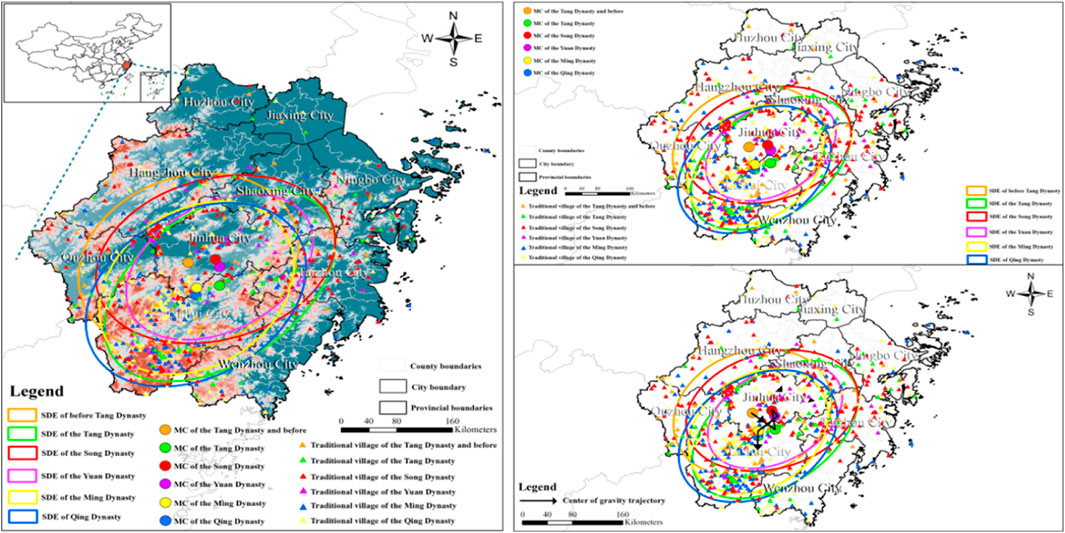
Figure 7. Standard deviation ellipse and center of gravity offset plot for traditional villages in Zhejiang Province.
It was situated north of Lishui City. During the Song Dynasty, it relocated to the southern region of Jinhua City. During the Yuan Dynasty, the equilibrium of power was only temporarily stabilized. During the Ming Dynasty, the center of gravity underwent a southern movement, specifically from the eastern part of Wuyi County to the northern part of Liandu District, and has continued to move southward. Lishui City emerged as the focal point of influence throughout the Qing Dynasty.
Figures 8, 9 show the statistical distribution of traditional communities at six different times in different forms (Xiao et al., 2024). In this study, the points of traditional villages in different periods are concentrated in one map (Figure 8). This map also reflects the distribution density characteristics of traditional villages in different periods (Figure 9). Their arrangement was entirely dispersed in the initial stages of forming traditional villages in Zhejiang Province. The geographical characteristicsThe spatial characteristics of the western section of Zhejiang, bordered by the cities of Hangzhou, Jinhua, and Quzhou, as well as the extensive Hangjiahu Plain in northern Zhejiang, are predominantly spread in this area. The Beijing-Hangzhou Grand Canal, constructed during the Tang Dynasty, was a vital link between China’s northern and southern regions. The dispersion of the traditional distribution of traditional communities followed a route analysis known as the “one point and one belt,” progressively spreading. However, during the Song Dynasty, the Song family moved to Lin’an and established their residence in Hangzhou due to an assault by Jin warriors from the Northern Song Dynasty.
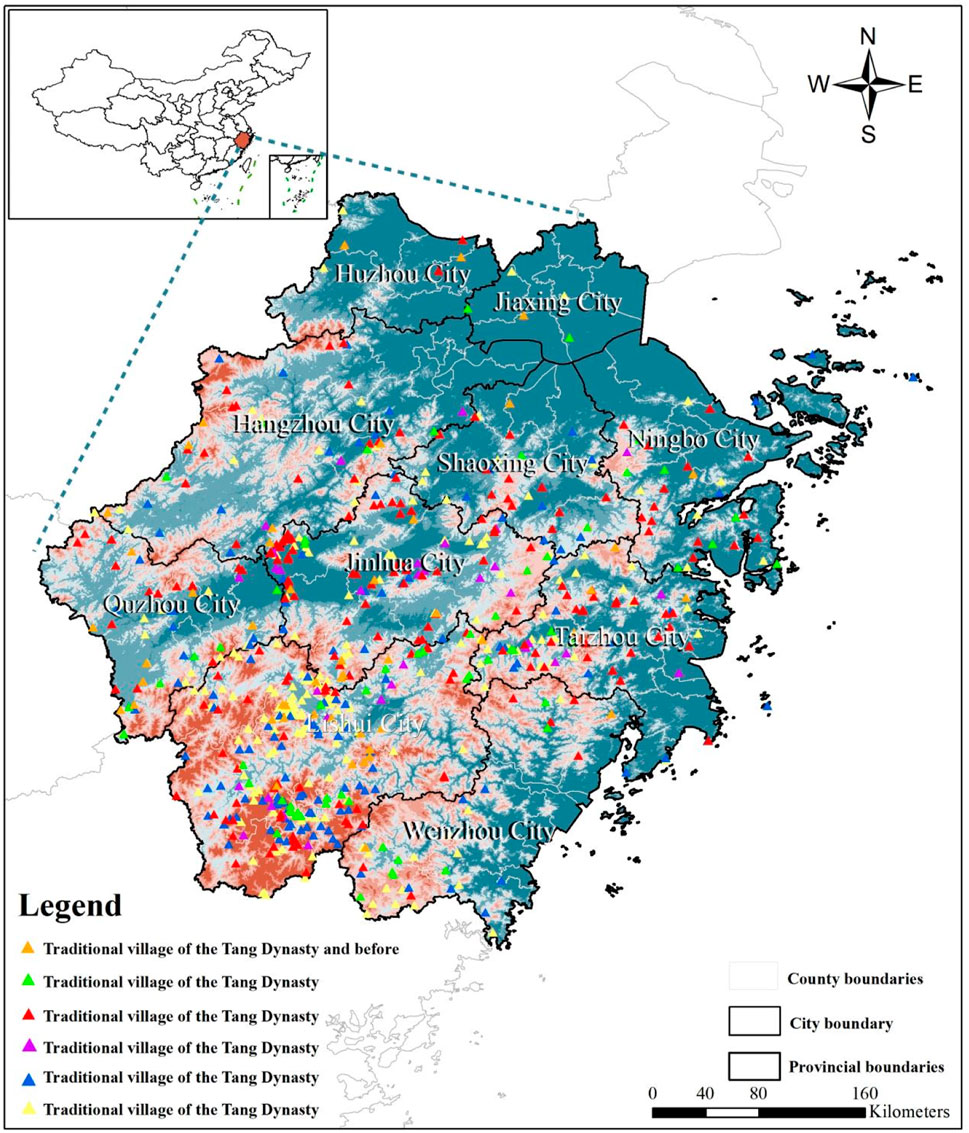
Figure 8. The spatial dispersion of traditional villages in Zhejiang Province under several dynasties.
Consequently, traditional villages experienced their initial surge in growth. Statistics indicate that the Song Dynasty had a significant rise in the number of traditional villages, with an increase of 196. These villages were predominantly characterized by a “one star, many points” and “continuous” distribution pattern.
During the Ming Dynasty, the rise of capitalism and socio-economic progress resulted in widespread piracy along the coastal regions. Consequently, the population living along the coast moved towards the interior, leading to a subsequent increase in the number of traditional villages in Zhejiang Province, reaching 222. A concentrated “single-core” distribution pattern of new communities has emerged mainly in Songyang County, Lishui. Typically, traditional communities ensure their safety by spreading along rivers and waterways, while the remaining villages are in mountainous regions. The Huangmaojian Mountain area in Longquan City exemplifies this. During the Qing Dynasty, the number of new traditional villages increased to 132, contributing to the expansion of the overall scale. The analysis of the figure indicates that under the Qing Dynasty, traditional villages saw growth and expansion towards the southwest; at the same time, the Ming Dynasty played a role in dividing and further developing many of these villages.
To summarize, traditional villages in Zhejiang Province follow three specific distribution patterns: In the Tang Dynasty, under the influence of the Beijing-Hangzhou Grand Canal, traditional villages practiced a “one point, one belt” distribution scheme. Currently, the distribution center of traditional villages in Zhejiang Province has moved to the southeast. During the Song and Yuan Dynasties, there was a clear shift to the southern mountainous areas, characterized by the emergence of many shifting cores and a consistent distribution pattern. Zhejiang Province practiced traditional village distribution. This trend was strengthened during the Ming and Qing dynasties, forming a “double-core” distribution pattern centered on Songyang County and Jingning She Autonomous County in Lishui. The spatial distribution pattern of traditional villages in Zhejiang Province has become increasingly stable, while other places show stable piecewise and linear features. This distribution pattern indicates that the development of traditional villages in the period of historical evolution was most influenced by political policies and ecological changes, showing that the distribution and layout of traditional villages are the effects of the joint influence of multiple factors. This finding verifies the profound influence of historical factors and natural conditions on the spatial layout of traditional villages.
3.2 Factors affecting different historical periods
3.2.1 The dominant role of natural geographic factors
This study is understood based on the analysis of the spatio-temporal evolution pattern. In the early historical period, especially during the Tang and Song dynasties, the layout of traditional villages in Zhejiang was heavily dominated by natural geographic factors (Turner et al., 2007). Villages were mostly built along the water, and priority was given to zones close to rivers, lakes and other water sources (Seto et al., 2012a) to meet the needs of water for agricultural irrigation and living, and at the same time, with the help of the natural water system to form an accessible environment conducive to commerce and transportation. The layout of villages based on water provided the necessary production conditions for the agricultural society (Lambin and Meyfroidt, 2011), ensured the stable production of food and cash crops, and, at the same time, formed a gathering space that was easy to defend. Therefore, with the change of dynasties and geopolitical changes, the mountainous areas with complex topography and developed water systems gradually became the core area of the new distribution of villages. This further reflects the dynamic and gradual dominant role of geographical factors in the distribution of villages.
3.2.2 Evolution and spatial migration of socioeconomic factors
With the development of economic activities and the diversification of social needs (Ostrom, 2009), especially in the context of the prosperous trade and commerce in the Song Dynasty. The spatial distribution of villages gradually concentrated towards the core areas with convenient transportation, forming settlement groups around important trade routes. However, during the Ming and Qing Dynasties, with the transfer of regional economic centers and the adjustment of national governance policies (Seto et al., 2012b), the distribution of villages gradually extended inland to remote areas. This decentralization process was not only in line with the self-sufficient economic model at that time but also benefited from the shelter of the natural environment, which provided a relatively stable living space for the villages. It reflects the process of village migration brought about by economic development.
3.2.3 Cultural policy factors shaping regional settlements
The Qing Dynasty’s policy measures, such as tunneling and settling the people in the Frontier areas, significantly influenced the layout and cultural identity of some traditional villages. It made the location and construction of Frontier villages have specific cultural markers. The policy in the Frontier areas promoted multi-ethnic and multi-cultural settlement patterns, giving these villages unique historical and cultural values. Reflecting the central regime’s need for cultural integration and cultural export from the Frontier areas, these villages have retained rich ethnic and cultural connotations, making them unique cases that cannot be ignored in studying traditional villages. This has led to distinct regional cultural characteristics in their subsequent development.
This study analyses the distribution characteristics of traditional villages in Zhejiang Province in different historical periods and their influencing factors. It can be understood that the social, economic, and natural factors in different eras have profoundly influenced the spatial distribution and site layout of traditional villages in Zhejiang Province. From the settlement along the water in the Tang Dynasty to the evolution of mountainous distribution in the Qing Dynasty, the layout of villages in different historical periods reflected the unique social needs, geographical conditions, and cultural values at that time. This spatial and temporal evolution reveals the development trajectory of traditional villages and implies the multiple factors behind the siting characteristics of different villages.
Based on this, the importance of profoundly analyzing the factors influencing the spatial distribution pattern of traditional villages is self-evident. We will further explore these specific influencing factors in the process of historical evolution and the implications of these factors in the modern conservation of traditional villages. Through detailed analysis of historical, geographical, and socio-economic factors, we will reveal the mechanism of different factors in a specific historical period and provide a scientific basis for contemporary traditional village conservation and planning.
Combining the influencing factors with the laws of historical evolution, it proposes locally adapted conservation strategies to realize village sustainable development and cultural inheritance.
4 Factors affecting spatial distribution
A complex combination of environmental factors shapes the influence mechanisms of traditional villages in Zhejiang Province. By organizing historical information data and utilizing ArcGIS multi-dimensional spatial analytic tools, we can condense this influence mechanism into three categories: 1. Factors related to geographical patterns. Elevation, slope, and direction are the main factors that primarily impact this occurrence. Geographic factors play a significant role in determining spatial distribution, with the spatial and temporal dimensions having a relatively minor effect (Gao et al., 2024). 2. Factors that have a natural influence. We examine these characteristics regarding climate, precipitation, and proximity to the river. Geographical dimensions, airflow, and water supplies significantly determine the distribution of traditional settlements (Maikhuri, 1996). 3. Factors related to the interaction between society and the economy. Over time, as the economy evolves, the impact of highways, urbanization rate, GDP, and population density on traditional villages becomes increasingly relevant. The research suggests a negative link between most of these parameters and the spread of traditional villages (Zhong et al., 2024).
4.1 Geographic pattern factors
The geographical distribution pattern significantly influences the spatial distribution of traditional villages in Zhejiang Province. For this study, we performed a data analysis on elevation, slope, and slope direction. Zhejiang Province has twelve prominent mountain ranges, such as Tianmu, Baiji, Qianligang, and Longmen, each with different altitudes. Traditional villages have been affected by their clustering, production capacity, and way of life. Zhejiang Province is home to 701 traditional villages at an average elevation of 314 m (Figures 10A). Five hundred thirty-nine communities, accounting for 77% of all traditional villages, are situated in mountain basins and hilly terrain below an elevation of 500 m. Out of these, 324 traditional villages are situated at an altitude below 200 m. Traditional villages are typically situated in low-elevation mountain basins, allowing for suitable agricultural acreage and nearby communities.

Figure 10. Factors affecting the evolution of traditional villages in Zhejiang Province in terms of altitude range, slope range and absect.
The slope element significantly influences the unique layout selection of traditional settlements (Figures 10B). Research indicates that most traditional villages in Zhejiang Province are on flat land with slight inclines, moderate slopes, and steep slopes with angles of 35° or less. These areas make up 99% of the total. The highest number of communities, totaling 226, are traditional villages with a slope ranging from 5° to 15°. Once the angle exceeds 35°, there is a significant decline in traditional villages. There are six conventional villages within the range of 35°–55°. However, those located above 55° do not have any distribution.
The slope’s inclination directly impacts the amount of sunshine and range of radiation that traditional settlements get (Figures 10C). The east, southeast, south, and southwest directions have the most significant number of traditional villages, with 101, 128, 121, and 110 villages. The northeastern and western directions have the second most excellent count of traditional villages, with 61 and 60, respectively. There are only six traditional communities in the plains. Most historic villages are situated in a north-south orientation and are evenly dispersed in all directions. The lighting in the area is sufficient to fulfill the requirements for sunlight exposure, maintain optimal temperature and rainfall levels for plant development, shield against cold winds from the north, and fully cater to the living needs of the residents.
4.2 Natural influencing factors
In the early stages, the spatial arrangement of traditional villages was primarily determined by factors related to agricultural output and human habitation. As the temperature decreases (Figures 11A), the duration of time ideal for crop growth decreases. According to, the average temperature value on the leftmost side is where the highest concentration of traditional villages is found, ranging from 17.7°C to 18°C. This temperature range is considered ideal for both living and working. Regions with higher levels of rainfall and ample water supplies are home to the bulk of traditional communities. The region with precipitation levels ranging from 1,200 to 1,500 has the highest volume of distributed water. There is a significant decline in the number of traditional villages in locations that receive less than 1,000 mm of precipitation (Figures 11B).

Figure 11. Factors affecting the evolution of traditional villages in Zhejiang Province in terms of air temperature, precipitation and distance from water systems.
Zhejiang Province encompasses eight prominent water systems (Figures 11C), such as the Qiantang River, Oujiang River, Yongjiang River, and Feiyun River, which collectively span a substantial water expanse. Typically, traditional settlements are heavily clustered around prominent rivers. The majority, or 85%, of the traditional villages are situated within a distance of 3 km from the rivers. Clustered within the 0–1,000 m range, they are situated near water sources, emphasizing the nearness of traditional settlements to these water sources.
4.3 Effects of societal influences
Transportation conditions significantly influence the development of traditional communities (Figures 12A). Traditional villages in Zhejiang Province have limited transportation infrastructure, particularly in heavily populated areas lacking roadways. On one side, this can decrease the likelihood that transportation conditions significantly influence traditional communities’ development. The traditional villages in Zhejiang Province need more transportation infrastructure, particularly in heavily populated areas lacking roadways. On one hand, this can restrict the possibilities for growth and devastation of traditional villages while simultaneously preserving the customs and culture of the inhabitants. There is an increasing disparity between traditional villages and the external world. Over time, the construction of urban and rural areas has changed traditional villages into towns, eventually eliminating their original rural scenery and characteristics. Consequently, the current traditional villages are primarily situated in regions characterized by low levels of urban development. It can be inferred that 80% of the traditional villages in Zhejiang Province (Figures 12B), which amounts to 557 villages, are situated in regions with an urbanization rate below 10%. There exist merely seven conventional villages exhibiting an urbanization rate of 16% or more. On one side, this can restrict the possibilities for the growth and demolition of traditional villages while simultaneously protecting the citizens’ habits and culture. Amidst conventional rural settlements, this establishes a distinct separation between conventional rural communities and the external society. Implementing development processes has gradually altered several traditional villages, transforming them into towns and disappearing their unique rural scenery and distinctive features. Consequently, the current traditional villages are primarily situated in regions characterized by low levels of urban development. Figure 11: The conclusion can be drawn that the value is 5. Figure 11 illustrates that 80% of the total traditional villages in Zhejiang Province are located in areas with an urbanization rate of less than 10%, encompassing a distribution of 557 villages. Refers to areas with an urbanization rate equal to or greater than 16%.
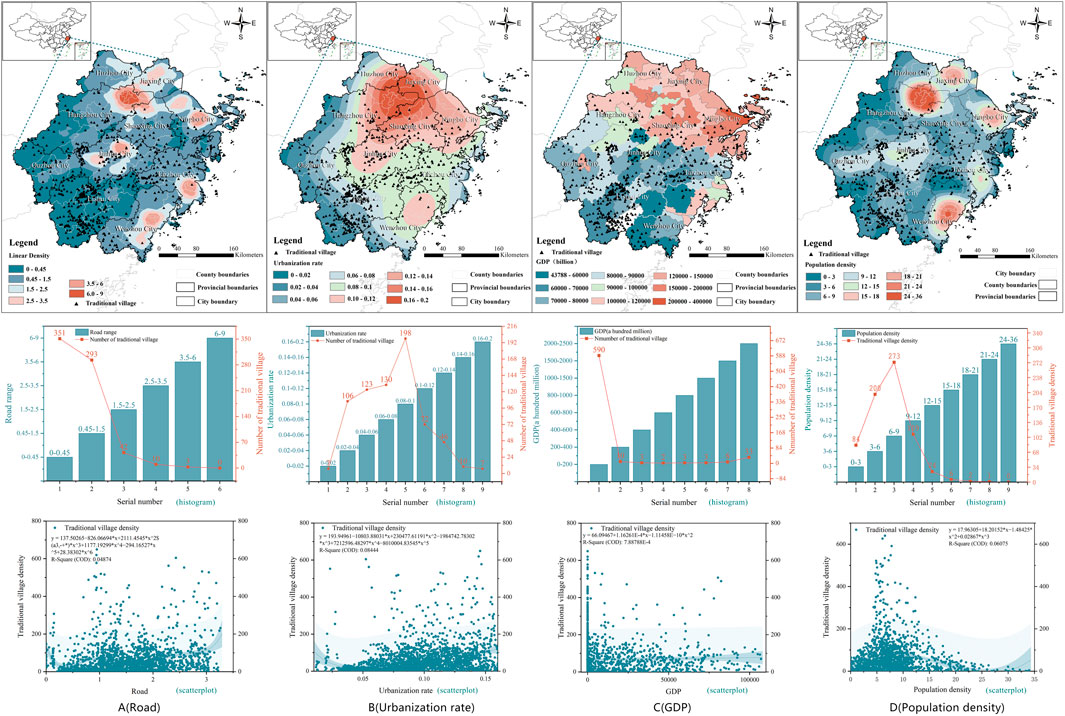
Figure 12. Factors affecting the evolution of traditional villages in Zhejiang Province in terms of roads, urbanisation rate, GDP and population density.
Traditional villages are frequently situated in economically underdeveloped provinces within the administrative boundaries of rapidly advancing societies (Figures 12C). Despite their relatively modest population, traditional villages exhibit a negative link with economic growth and population density. Figure 12 illustrates that there are 590 traditional villages with a GDP ranging from 0 to 20 billion yuan, making up 84% of the total. The number of conventional villages in high-GDP regions like Hangzhou, Shaoxing, and Ningbo is minimal. The rapid economic growth and dense population in specific locations tend to destroy traditional communities gradually (Figures 12D), ultimately decreasing the probability of their survival. Social considerations have a substantial impact on the spatial distribution of traditional villages.
5 Analysis of factors influencing spatial distribution
5.1 Factors that have a singular impact on a certain outcome
This study examined eleven significant parameters that impact the outcome: height, elevation, slope, slope direction, temperature, precipitation, distance from a river or road, urbanization rate, GDP, and population density (Bi et al., 2024). The natural breakpoint approach examined the study’s height, slope, and direction variables. We determined the river distribution by calculating the straight-line distance between the coordinate point of the traditional hamlet and the closest river in a hierarchical manner. The kernel density analysis utilized data from the Statistical Yearbook of Zhejiang Province to examine the distribution features of traditional villages in each city and county. The analysis considered temperature, precipitation, roads, urbanization rate, and population density.
By employing the geodetector research method (Refer to 2.3.6 for a specific explanation of the research approach). Raster data for each influence factor was extracted, and the data was counted, combed, and placed in the geodetector tool to summarize and draw conclusions. An analysis was conducted on the factors influencing traditional villages in Zhejiang Province. In this study, the q-values of the influencing factors are listed in order of influence (Table 4). The q-values for each influence factor are listed in the following order: Precipitation (0.27)>Altitude (0.22)>Road (0.17)>Population density (0.16)>River system (0.15)>Abstract (0.12)> Urbanization rate (0.10)>Air temperature (0.08)>Slope (0.03)>GDP (0.02) (The q-value is calculated from the detector metrics and reflects the explanatory power of the independent variable X over the dependent variable Y). The spatial distribution of traditional villages in Zhejiang Province is substantially influenced by precipitation, elevation, and transportation conditions. He impact characteristics are population density, proximity to the water system, slope direction, urbanization rate, and air temperature. Finally, we analyze the influence of slope and GDP on traditional villages in Zhejiang Province. Out of all the factors, precipitation had the most significant impact, suggesting that traditional communities in Zhejiang Province had a high affinity for water. Lifestyle substantially influences individuals’ productivity and consumption needs, whereas the river continually shapes the location of traditional settlements. The factor of influence on GDP, with a q value of 0.02, demonstrates the least significant impact.
5.2 Two-factor interaction factors
Multiple factors contribute to the presence of diverse interaction effects. This study examines the combined explanatory ability of two-factor interaction factors utilizing the interactive detector module of Geodetector (Luyi et al., 2024). The evaluation involves computing the q-values of the factors X1 and X2 on Y, denoted as q (X1) and q (X2), respectively. Additionally, the q-value is calculated when X1 and X2 interact, denoted as q (X1 ∩ X2). The assessment compares the q-values of X1 and X2 with the q-value of their interaction, q (X1 ∩ X2).
The interaction effects that have the highest significance are elevation intersecting water system (q = 0.63), water system intersecting water system (q = 0.57), and slope direction intersecting precipitation (q = 0.54), respectively (Figure 13). The spatial distribution of traditional villages in Zhejiang Province is mainly influenced by the interaction of elevation and water systems. The primary factors with the greatest q-values in the single-factor influencing factor and the two-factor interaction influencing factor are the elevation, precipitation, slope direction, and water system. The spatial arrangement of natural topography and the allocation of water resources significantly influence the positioning of traditional villages in Zhejiang Province. The q-value for the interaction impact of GDP is consistently the lowest, usually dropping below the average value. Within Zhejiang Province, 27 traditional villages have an interaction coefficient q-value below 0.33. These villages comprise 50% of the total number of villages in the province. This illustrates the intricate and varied effects of two-factor interactions on the spatial distribution of traditional villages in Zhejiang Province. It can be seen that among the influencing factors of traditional villages, elevation, precipitation, slope direction and water system have the greatest influence, which explains that traditional villages in Zhejiang Province are mainly dominated by geographic and natural factors in site selection and layout.
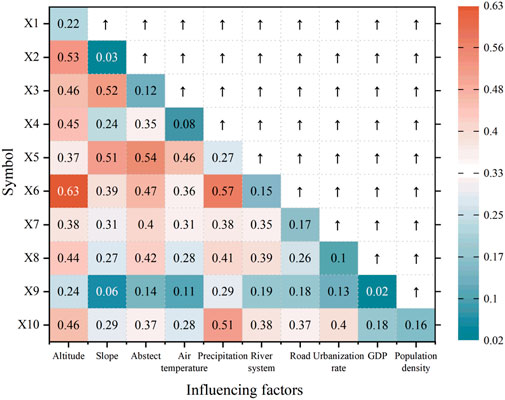
Figure 13. Coefficients of interaction among factors influencing traditional villages in Zhejiang Province.
6 Discussion
In recent years, there has been a gradual increase in the number of studies on the spatial evolution and distribution patterns of traditional villages, and previous studies have generally revealed that traditional villages in China present obvious aggregation characteristics (Fang et al., 2023). However, most of the studies are based on the national large-scale or local micro-scale, and there is a lack of multi-dimensional systematic analysis of the coupling relationship between multi-dimensional influencing factors and spatial and temporal evolution in specific regions of Zhejiang Province.
Compared with existing studies, the main contributions of this study lie in the following three points: First, in terms of research scale, this study focuses more on the specific region of Zhejiang Province, which provides a more detailed analysis of spatial-temporal evolution and spatial distribution and supplements the limitations of the national scale analysis; second, in terms of analytical methods, it elaborates the spatial distribution characteristics of the traditional villages, their historical evolution, the influencing factors, and their influencing factors in terms of the single-factor and double-factor interaction results, which provides a better understanding for the traditional villages and provides a better understanding of their spatial-temporal evolution. factor interaction results, providing a new methodological framework for traditional villages research, i.e., using kernel density analysis, coefficient of variation, nearest neighbor Index, imbalance index, etc., to understand the spatial distribution characteristics of traditional villages and their driving mechanisms, which transcends the analysis of single-dimensional factors. Thirdly, it is the first attempt to draw on the analytical perspective of spatial interaction and finds that the spatial interaction mechanism is of significant significance in the synergistic effects of optimal allocation of regional resources and sustainable conservation and development of villages, expanding the scope of application of the traditional research methods. The influencing factors of national political strategies and ecological changes are analysed from the historical evolution of time, and then the influencing factors among geographical, natural, and social factors are deconstructed from spatial and social realities. It enriches the theoretical basis of spatial layout research and provides new perspectives and ideas for future exploration of the conflict between traditional villages and modernisation and urbanisation. It provides an important research basis for the protection and sustainable development of traditional villages in Zhejiang Province.
6.1 Spatial distribution characteristics and driving mechanisms
The spatial distribution of traditional villages in Zhejiang Province shows significant regional characteristics and spatial agglomeration. The villages are primarily located in water areas with low terrain and abundant resources, while the distribution in the mountainous areas is relatively scattered. This study’s results show that traditional villages’ spatial distribution characteristics are not random but driven by natural geographic and socioeconomic factors. Particularly under the influence of natural resource availability and transportation accessibility, villages show a dependent layout. This reflects villages’ high degree of adaptation to the natural environment and their response to social needs. Such spatial agglomeration and distribution characteristics reflect the spatial organization of villages at different historical stages. It provides theoretical support for understanding the layout characteristics of villages. The future conservation strategy should fully consider the distribution pattern of villages and implement strict protection in resource-rich and ecologically sensitive areas. At the same time, it is allowed to conduct reasonable development in suitable areas to achieve the dual goals of ecological protection and economic development.
6.2 Influence of historical evolution process on spatial pattern
The historical evolution process has significantly influenced the spatial pattern of traditional villages, and the social needs and policy orientations of different historical periods have been reflected in the layout of villages. In the early days, the layout of villages was focused on water sources and resources to satisfy basic survival needs. With the complexity of social structure and economic development, villages gradually clustered towards transportation hubs and economic centers to support commercial and exchange activities. Studies have shown that historical evolution not only changed the spatial distribution characteristics of villages but also transformed their socio-economic functions. During the Ming and Qing dynasties, the distribution of villages further expanded to remote mountainous areas as the self-sufficient economic model took shape. This change in pattern reflected the village’s adjustment strategy in response to external economic changes. Therefore, the historical evolution has a strong continuity in the characteristics of the village layout, but stage-by-stage structural changes also accompany it. The future conservation strategy must be based on understanding this historical evolution pattern and selecting a suitable village development mode to maintain its continuity in modern society.
6.3 Single and two-factor interactions between multifactors
Among the single-factor influences, the natural geographic factors of precipitation and topographic elevation are the core natural factors for traditional village site selection. The availability of water sources significantly affected the distribution density of villages, and low-lying areas along rivers were preferred for their irrigation convenience. Topography significantly impacts the defensive layout of villages, especially in mountainous areas with high terrain, where villages tend to adopt a decentralized layout to cope with the threat of natural disasters, among the socio-economic factors. With the development of the social economy, the village layout gradually shows adaptive changes. The dense distribution of villages in economically developed areas reflected the demand for commerce and trade, while the layout of villages in economically backward mountainous areas was more sparse. The economic drive of this layout was especially significant in the Song Dynasty, where trade centers’ formation drove villages’ centralization. At the same time, the agricultural social model of the Ming and Qing Dynasties led to a dispersed distribution of villages. This trend is presented in the development of modern society.
In the two-factor interaction effect analysis. The traditional village layout is particularly significant regarding the interaction between elevation and water systems. Low-lying but water-rich areas are suitable for agricultural development and attract many people due to transportation accessibility, resulting in a higher density of village distribution in the region. Similarly, in resource-rich mountainous areas, socio-economic factors drive villages to form a unique adaptive layout within the constraints of the natural environment. This two-factor interaction makes the distribution pattern of villages more adaptive. It meets the requirements of the natural conditions and the changes in social needs.
This interaction shows that in the protection and development strategy of the village. The dual influence of nature and society must be considered comprehensively to ensure a scientific and effective conservation strategy. Future conservation efforts should focus on the synergistic relationship between different factors. Maintaining the integrity of natural geographic conditions and adapting to modern social and economic development needs is necessary to realize the sustainable development of traditional villages.
6.4 Research results and strategies for their protection
This study reveals the multiple mechanisms of the spatial layout and influencing factors of traditional villages, which provides systematic guidance for future village conservation and development strategies. First, villages’ spatial distribution and historical evolution patterns indicate that natural environmental adaptations and socio-economic dynamic adjustments are the core driving factors of village layout. For this reason, future conservation efforts should implement strict ecological protection strategies in sensitive natural environment areas. This is especially true for water sources and areas rich in ecological resources to prevent development from infringing on the natural environment of villages. Secondly, the regulatory role of socio-economic factors on village layout suggests. The protection of traditional villages should not only remain static material protection but also be given new functions from the perspective of modern economic development. Innovative economic models, such as cultural tourism and rural industry development, can energize the villages to gain momentum for revival and sustainable development in the modern economic system.
In addition, the two-factor interaction provides a basis for categorized conservation strategies. Ecological protection and resource management should be the core for villages dominated by natural geographic factors. For villages significantly influenced by socio-economic factors, policy guidance, and resource investment can be used to promote their economic revitalization and safeguard their social functions. To sum up, the protection and development of traditional villages need to seek a balance between natural adaptability and economic vitality to realize the long-term sustainable development of villages.
7 Conclusion
By quantitatively analyzing the spatial distribution, historical evolution and the interaction of multiple factors of traditional villages in Zhejiang Province, this study reveals the complex dynamic relationship between village layout and natural geographic and socio-economic factors. The unique patterns of traditional villages in Zhejiang Province in terms of geographical adaptation, historical evolution, and modern transformation are demonstrated. The findings not only complement the study of spatial characteristics of traditional settlements in China but also provide potential comparative references for the conservation and development of traditional settlements in other regions around the globe.
7.1 Spatial distribution of aggregation characteristics
This study finds that the spatial distribution of traditional villages in Zhejiang Province presents an unbalanced feature of a “double core, scattered periphery” concentrated in the resource-rich and conveniently located Lishui and Jinhua cities. Compared with the scattered distribution pattern of villages in other regions, this aggregated layout reflects the guiding role of water resources, topography and transportation networks in forming villages. It provides a comparative perspective for understanding the layout patterns of traditional villages in diverse natural resource environments. Especially under the global trend of urbanization, this clustered distribution shows the survival and development of traditional villages through geographical environment and resource endowment. It is also a revelation for other regions regarding ecological protection and rational resource utilization.
7.2 Historical lineage of spatial and temporal evolution
The development of traditional villages in Zhejiang began before the Tang Dynasty. It peaked several times during the Song, Ming and Qing Dynasties, accompanied by the migration of the centre of gravity of villages from the northeast to the southwest. This trend not only fits the dynamic changes in the socio-economic and political patterns at that time. It also highlights the spatial adaptation of villages driven by both the natural environment and social needs. Compared with other regions, villages in the natural and social conflicts in the “decentralization” trend. The spatial and temporal migration patterns of traditional villages in Zhejiang show their intrinsic resilience in response to changes in the regional environment. This provides an important reference for exploring the sustainable strategies of traditional settlements in the change process.
7.3 Mechanisms of impact under multifactorial influences
The formation of traditional village layout results from the combined effect of natural geographic and socioeconomic factors, with water resources and topography playing a dominant role in the distribution of villages. Socioeconomic factors, on the other hand, have become the regulating force of the layout through changes in economic patterns and policies at different stages in history. Specifically, the prosperity of commerce and trade in the Song Dynasty contributed to the concentration of villages in transportation hubs. At the same time, the self-sufficient economic model of the Ming and Qing Dynasties led to the gradual spread of villages to mountainous areas. Unlike the “resource center-periphery” model of traditional settlement studies around the world, the findings of this study show that the socioeconomic pattern of the villages is not the same as that of the traditional settlements in the world. The findings of this study demonstrate the interaction between socioeconomic and physical-geographic factors under specific regional conditions and provide important lessons for cross-regional models of settlement conservation and sustainable development.
7.4 Shaping cultural policies and regional cultural diversity
The policy of cantonment in the Qing Dynasty enriched the diversity of traditional villages in Zhejiang’s Frontier through multiethnic cultural integration, forming a unique regional cultural identity. This phenomenon is uncommon in the study of global traditional settlements and provides a typical case of policy guidance and cultural diversity in forming multicultural settlements. The political strategies and cultural exports of different dynasties under the historical evolution have brought conflicts and impacts on the changes in traditional villages. Demonstrate the influence of policy factors on cultural identity and local characteristics. Therefore, regional conservation planning combines local characteristics and practical needs. Focusing on the adaptive inheritance of culture, innovative forms of cultural activities and festivals attract the participation of the younger generation to ensure that the culture of traditional villages can evolve and continue in modern society. The intrinsic integration of multiple cultures provides a new way of thinking about cultural protection and the inheritance of regional characteristics in the context of globalization.
7.5 Extended discussion and global protection strategy
This study reveals the complex mechanisms of traditional villages in Zhejiang Province under the influence of spatial distribution, natural adaptation, and socio-economic impacts. A conservation strategy centered on ecological protection, cultural heritage, and economic transformation is proposed. Resource-rich areas rationally utilize ecological protection and natural resources and restore and protect water sources, rivers, and mountain ecosystems to enhance the resilience of traditional villages. Referring to the model of laying out villages according to the watershed and topography in this study, the conservation work is carried out from the perspective of geographic adaptability. Economically marginalized areas can achieve sustainable development through industrial revitalization and cultural tourism to avoid the excessive decline of traditional settlements. Secondly, it emphasizes the core position of cultural heritage transmission in village protection. It develops differentiated strategies by considering local cultural contexts and innovative paths of cultural heritage protection by digital means. At the same time, drawing on the policy recommendations put forward by Valjarević et al. in their study of urban-rural settlement interaction in Serbia, this study argues that strengthening the spatial interaction between traditional villages and neighbouring towns in Zhejiang will help to realise the integration and sharing of resources, thus promoting a win-win situation for the coordinated development of the region and the protection of traditional villages.
The study provides a comprehensive framework for protecting traditional villages worldwide, combining the three core elements of ecological protection, cultural heritage, and economic transformation to provide sustainable development solutions for traditional villages facing the pressure of modernization. Secondly, it emphasizes innovative paths for cultural heritage protection, an important model for digitalizing traditional culture, and the innovation of protection models. Finally, it provides economically marginalized regions with feasible solutions, combining industrial revitalization and cultural tourism to help them achieve economic revival while preserving cultural heritage. The framework provides valuable experience for multi-countries and regions in preserving cultural heritage and realizing sustainable development. It promotes cross-cultural dialogue and cooperation in preserving traditional villages worldwide.
7.6 Limitations and future prospects
The limitation of this study mainly lies in the fact that the research object focuses on the villages in Zhejiang Province that are included in the list of Chinese traditional villages. Some villages not included in the list were not counted, which may affect the generalizability of the conclusions. In addition, this study mainly focuses on the spatial characteristics and influencing factors at the macro level and has yet to explore the details of village construction and cultural changes at the micro level. Future research could be in the broader region and a more detailed perspective. It will explore the association between the cultural characteristics, spatial patterns, and conservation patterns of villages in different regions. It will also provide more comprehensive theoretical support for studying the conservation and cultural inheritance of traditional settlements worldwide.
In summary, this study reveals the spatial distribution, historical evolution, and multi-factor interaction mechanism of traditional villages in Zhejiang Province. It demonstrates the diversified development paths of villages under the dependence on natural resources, socio-economic regulation, and policy guidance. The study results provide systematic guidance for conserving traditional settlements in China and practical insights into the sustainable conservation and cultural inheritance of traditional settlements in the worldwide modernization process. The conservation strategies proposed in this study are widely applicable in diverse settlement environments and will provide theoretical and practical support for conserving traditional settlements in other regions.
Data availability statement
The original contributions presented in the study are included in the article/supplementary material, further inquiries can be directed to the corresponding author.
Author contributions
YG: Conceptualization, Data curation, Writing – original draft, Writing – review and editing. LW: Methodology, Writing – original draft. NZ: Methodology, Writing – review and editing. JH: Writing – review and editing.
Funding
The author(s) declare that no financial support was received for the research and/or publication of this article.
Conflict of interest
The authors declare that the research was conducted in the absence of any commercial or financial relationships that could be construed as a potential conflict of interest.
Generative AI statement
The author(s) declare that no Generative AI was used in the creation of this manuscript.
Publisher’s note
All claims expressed in this article are solely those of the authors and do not necessarily represent those of their affiliated organizations, or those of the publisher, the editors and the reviewers. Any product that may be evaluated in this article, or claim that may be made by its manufacturer, is not guaranteed or endorsed by the publisher.
References
Bi, S., Du, J., Tian, Z., and Zhang, Yi (2024). Investigating the spatial distribution mechanisms of traditional villages from the human geography region: a case study of Jiangnan, China. Ecol. Inf. 81, 102649. doi:10.1016/j.ecoinf.2024.102649
Chen, L. K., Zhong, Q. K., and Li, Z. (2023). Analysis of spatial characteristics and influence mechanism of human settlement suitability in traditional villages based on multi-scale geographically weighted regression model: a case study of Hunan province. Ecol. Indic. 154, 110828. doi:10.1016/j.ecolind.2023.110828
Chen, X., Xie, W., and Li, H. (2020). The spatial evolution process, characteristics and driving factors of traditional villages from the perspective of the cultural ecosystem: a case study of Chengkan Village. Habitat Int. 104, 102250.doi:10.1016/j.habitatint.2020.102250
Chen, Z. Y., Yang, H. G., Lin, Y. S., Xie, J. H., Xie, Y. Q., and Ding, Z. (2024). Exploring the association between the built environment and positive sentiments of tourists in traditional villages in Fuzhou, China. Ecol. Inf. 80, 102465. doi:10.1016/j.ecoinf.2024.102465
Ding, C. R., Li, G., and Yao, J. M. (2024). Nuclear matrix elements of neutrinoless double-beta decay in covariant density functional theory with different mechanisms. Phys. Lett. B 856, 0370–2693. doi:10.1016/j.physletb.2024.138896
Donaldson, M. P., Edwards, K. J., Meharg, A. A., Deacon, C., and Davidson, D. A. (2009). Land use history of village bay, hirta, st kilda world heritage site: a palynological investigation of plaggen soils. Rev. Palaeobot. Palynology 153 (Issues 1-2), 46–61. doi:10.1016/j.revpalbo.2008.06.005
Duan, X. J., Ma, Y., Zhou, Y. Q., Huang, H., and Wang, B. (2023). A novel cluster validity index based on augmented non-shared nearest neighbors. Expert Syst. Appl. 223, 119784. doi:10.1016/j.eswa.2023.119784
Fang, Y. L., Lu, H. Y., Huang, Z. F., and Zhu, Z. G. (2023). Spatiotemporal distribution of Chinese traditional villages and its influencing factors.Econ. Geogr. 43(9): 187–196. doi:10.15957/j.cnki.jjdl.2023.09.020
Fu, J., Zhou, J. L., and Deng, Y. Y. (2021). Heritage values of ancient vernacular residences in traditional villages in Western Hunan, China: spatial patterns and influencing factors. Build. Environ. 188, 107473. doi:10.1016/j.buildenv.2020.107473
Gao, C., Wu, Y., Bian, C., and Gao, X. (2021). Spatial characteristics and influencing factors of Chinese traditional villages in eight provinces the Yellow River flows through. River Res. Appl. 39, 1255–1269. doi:10.1002/rra.3880
Gao, W. J., Zhuo, X. L., and Xiao, D. W. (2024). Spatial patterns, factors, and ethnic differences: a study on ethnic minority villages in Yunnan, China. Heliyon 10 (6), e27677–e28440. doi:10.1016/j.heliyon.2024.e27677
Hong, J. C., Liang, F. W., Chen, Y. J., Wang, F. C., Zhang, X. Y., Li, K. R., et al. (2024). A novel battery abnormality diagnosis method using multi-scale normalized coefficient of variation in real-world vehicles. Energy 299, 0360–5442. doi:10.1016/j.energy.2024.131475
Jia, S. Y., Isa, MHBM, and Aziz, Z. B. A. (2023). Spatial characteristics of defensive traditional architecture in multiethnic village of Guangxi: case studies of Mozhuang Village and Guxietun Village. Front. Archit. Res. 12 (4), 683–699. doi:10.1016/j.foar.2023.05.003
Jianwei, H., Liang, S., Min, Y., Chunju, Z., Shuiping, L., Zhenxuan, L., et al. (2022). Quantitative spatial analysis of thermal infrared radiation temperature fields by the standard deviational ellipse method for the uniaxial loading of sandstone. Infrared Phys. and Technol. 123, 1350–4495. doi:10.1016/j.infrared.2022.104150
Lambin, E. F., and Meyfroidt, P. (2011). Global land use change, economic globalization, and the looming land scarcity. Proc. Natl. Acad. Sci. 108 (9), 3465–3472. doi:10.1073/pnas.1100480108
Li, B. H., Yang, F. D., Long, X. Y., Liu, X. Y., Cheng, B., and Dou, Y. D. (2024b). The organic renewal of traditional villages from the perspective of logical space restoration and physical space adaptation: a case study of Laoche village, China. Habitat Int. 144, 102988. doi:10.1016/j.habitatint.2023.102988
Li, M. R., Cao, Y., and Li, G. W. (2023b). An approach to developing and protecting linear heritage tourism: the construction of cultural heritage corridor of traditional villages in Mentougou District using GIS. Int. J. Geoheritage Parks 11 (4), 607–623. doi:10.1016/j.ijgeop.2023.11.002
Li, X. Q., Yang, Q. C., Lyu, X. Y., Ye, Y., and Zhang, B. (2023a). Multidimensional framework for analyzing the distribution patterns of traditional villages in the karst landscape regions of China. Ecol. Inf. 77, 102184. doi:10.1016/j.ecoinf.2023.102184
Li, X., W, Z. H., Xia, B., Chen, S. C., and Chen, S. L. (2019). Testing the associations between quality-based factors and their impacts on historic village tourism. Tour. Manag. Perspect. 32, 2211–9736. doi:10.1016/j.tmp.2019.100573
Li, Y. N., Ismail, M. H. A., and Aminuddin, A. (2024a). How has rural tourism influenced the sustainable development of traditional villages? A systematic literature review. Heliyon 10 (4), 2405–8440. doi:10.1016/j.heliyon.2024.e25627
Liu, F., Wang, J. Y., and Liu, Y. (2024). IMI2: a fuzzy clustering validity index for multiple imbalanced clusters. Expert Syst. Appl. 238 (Part E), 122231. doi:10.1016/j.eswa.2023.122231
Long, T. X., Işık, C., Yan, J. L., and Zhong, Q. K. (2024). Promoting the sustainable development of traditional villages: exploring the comprehensive assessment, spatial and temporal evolution, and internal and external impacts of traditional village human settlements in hunan province. Heliyon 10 (11), 2405–8440. doi:10.1016/j.heliyon.2024.e32439
Luisa, L., Manfredi, S., and Tiziana, C. (2023). Smart technological tools for rising damp on monumental buildings for cultural heritage conservation. A proposal for smart villages implementation in the Madonie montains (Sicily). Sustain. Futur. 6, 2666–1888. doi:10.1016/j.sftr.2023.100116
Luyi, Y., Xuan, J., Meng, L., Pengwu, Y., Wei, J., Linyan, C., et al. (2024). A comprehensive framework for assessing the spatial drivers of flood disasters using an optimal Parameter-based geographical Detector–machine learning coupled model. Geosci. Front. 15 (6), 101889. doi:10.1016/j.gsf.2024.101889
Ma, H. D., and Tong, Y. Q. (2022). Spatial differentiation of traditional villages using ArcGIS and GeoDa: a case study of Southwest China. Ecol. Inf. 68, 1574–9541. doi:10.1016/j.ecoinf.2021.101416
Maikhuri, R. K. (1996). Eco-energetic analysis of village ecosystem of different traditional societies of Northeast India. Energy 21 (12), 1287–1297. doi:10.1016/0360-5442(96)00032-1
Meng, C. Y., Chen, Y. M., Yang, J. X., Su, X. Y., Guo, W., and Zhang, K. L. (2024). Association between multilevel landscape characteristics and rural sustainability: a case study of the water-net region in the Yangtze River Delta, China. Ecol. Inf. 82 (2024), 102677. doi:10.1016/j.ecoinf.2024.102677
Noy, I. (2023). Waiting for displacement: land, compensation, and spatiotemporal inequality in a mining-affected Indian village. Geoforum 144, 103821. doi:10.1016/j.geoforum.2023.103821
Ostrom, E. (2009). A general framework for analyzing sustainability of social-ecological systems. Science 325 (5939), 419–422. doi:10.1126/science.1172133
Plieninger, T., Höchtl, F., and Spek, T. (2006). Traditional land-use and nature conservation in European rural landscapes. Environ. Sci. and Policy 9 (4), 317–321. doi:10.1016/j.envsci.2006.03.001
Schillaci, M. A., and Schillaci, M. E. (2022). Estimating the population variance, standard deviation, and coefficient of variation: sample size and accuracy. J. Hum. Evol. 171, 0047–2484. doi:10.1016/j.jhevol.2022.103230
Seto, K. C., Güneralp, B., and Hutyra, L. R. (2012a). Global forecasts of urban expansion to 2030 and direct impacts on biodiversity and carbon pools. Proc. Natl. Acad. Sci. 109 (40), 16083–16088. doi:10.1073/pnas.1211658109
Seto, K. C., Reenberg, A., Boone, C. G., Fragkias, M., Haase, D., Langanke, T., et al. (2012b). Urban land teleconnections and sustainability. Proc. Natl. Acad. Sci. 109 (20), 7687–7692. doi:10.1073/pnas.1117622109
Tang, C. C., Yang, Y. Y., Liu, Y., and Xiao, X. Y. (2023). Comprehensive evaluation of the cultural inheritance level of tourism-oriented traditional villages: the example of Beijing. Tour. Manag. Perspect. 48, 101166. doi:10.1016/j.tmp.2023.101166
Turner, B. L., Lambin, E. F., and Reenberg, A. (2007). The emergence of land change science for global environmental change and sustainability. Proc. Natl. Acad. Sci. 104 (52), 20666–20671. doi:10.1073/pnas.0704119104
Valjarević, A., Filipović, D., Živković, D. M., Ristić, N., Božović, J., and Božović, R. M. (2020). Spatial analysis of the possible first Serbian conurbation. Appl. Spatial Analysis Policy 14, 113–134. doi:10.1007/s12061-020-09348-1
Wang, D., Ji, X., Jiang, D. P., and Liu, P. (2022a). Importance assessment and conservation strategy for rural landscape patches in Huang-Huai plain based on network robustness analysis. Ecol. Inf. 69, 1574–9541. doi:10.1016/j.ecoinf.2022.101630
Wang, L. J., Gong, J. W., Ma, S., Wu, S., Zhang, X. M., and Jiang, J. (2022b). Ecosystem service supply-demand and socioecological drivers at different spatial scales in Zhejiang Province, China. Ecol. Indic. 140, 1470–160X. doi:10.1016/j.ecolind.2022.109058
Xiao, J., Qiao, J. J., Han, D., Ma, Y. L., Zhu, Q. K., and Wang, W. W. (2024). Spatial distribution and transformation mechanism of specialized villages in typical agricultural areas: case study of Henan province, China. Habitat Int. 146, 0197–3975. doi:10.1016/j.habitatint.2024.103034
Xu, Y., and Lu, L. (2024). Probing the long-term evolution of traditional village tourism destinations from a glocalisation perspective: a case study of Wuzhen in Zhejiang province, China. Habitat Int. 148 (2024), 0197–3975. doi:10.1016/j.habitatint.2024.103073
Zhang, Y., Zhang, L. Q., Wang, J. Y., Dong, G. C., and Wei, Y. L. (2023). Quantitative analysis of NDVI driving factors based on the geographical detector model in the Chengdu-Chongqing region, China. Ecol. Indic. 155, 110978–160X. doi:10.1016/j.ecolind.2023.110978
Zhao, X. G., Xue, P. C., Wang, F., Qin, Y., Duan, X. W., and Yang, Z. J. (2024). How to become one? The modern bond of traditional villages in centralized The modern bond of traditional villages in centralized contiguous protection and utilization areas in China. Habitat Int. 145, 0197–3975. doi:10.1016/j.habitatint.2024.103018
Zhong, Q. K., Fu, H. P., Yan, J. L., and Li, Z. (2024). How does energy utilization affect rural sustainability development in traditional villages? Re- examination from the coupling coordination degree of atmosphere-ecology-socioeconomics system. Build. Environ. 257, 0360–1323. doi:10.1016/j.buildenv.2024.111541
Keywords: traditional villages, GIS spatial analysis, geoprobe, space pattern, space-time evolution, Zhejiang Province, China
Citation: Guo Y, Wang L, Zhang N and Huang J (2025) Spatio-temporal evolution and spatial patterns of traditional villages under multi-dimensional influential factors—a case study of Zhejiang Province, China. Front. Earth Sci. 13:1543256. doi: 10.3389/feart.2025.1543256
Received: 11 December 2024; Accepted: 06 May 2025;
Published: 27 May 2025.
Edited by:
Shruti Kanga, Central University of Punjab, IndiaReviewed by:
Aleksandar Valjarević, University of Belgrade, SerbiaArulmalar Ramaraj, Sathyabama Institute of Science and Technology, India
Copyright © 2025 Guo, Wang, Zhang and Huang. This is an open-access article distributed under the terms of the Creative Commons Attribution License (CC BY). The use, distribution or reproduction in other forums is permitted, provided the original author(s) and the copyright owner(s) are credited and that the original publication in this journal is cited, in accordance with accepted academic practice. No use, distribution or reproduction is permitted which does not comply with these terms.
*Correspondence: Yanlong Guo, MjAxMDZAYWh1LmVkdS5jbg==
†These authors have contributed equally to this work
 Yanlong Guo
Yanlong Guo Longhao Wang
Longhao Wang Ning Zhang
Ning Zhang Jie Huang4
Jie Huang4